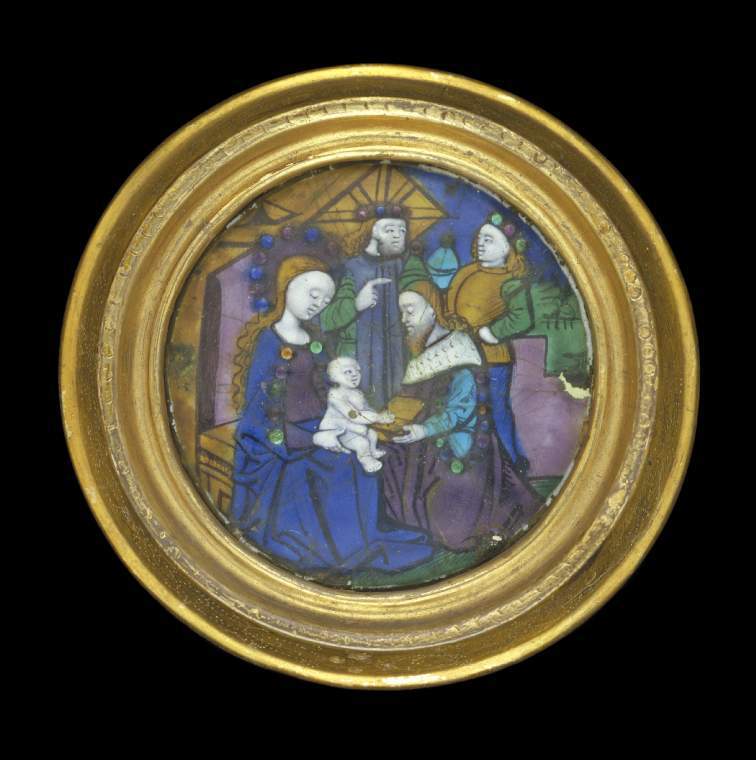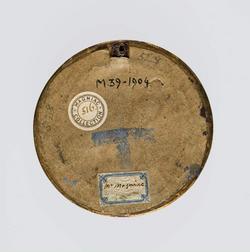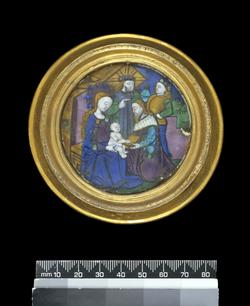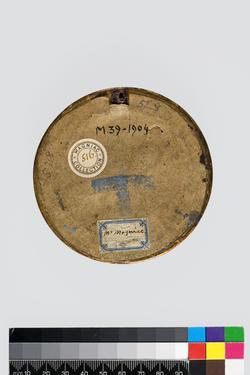Current Location: In storage
Titles
The Adoration of the Magi
Maker(s)
Production:
Pénicaud workshop
(Possibly)
Production:
Master of the High Foreheads
(Possibly)
Entities
Categories
Description
Copper roundel decorated with polychrome enamels, and some jewelling over paillons, in circular gilt-wood frame. The Virgin sits with the Christ Child on her lap on the left in front of the gable end of a building. One king kneels to present a casket while the other two kings stand behind her.
Circular very slightly convex copper plaque with a small hole on each side, painted in multi-couche technique in blue, greyish-blue, green, turquoise, pale yellowish-brown, mulberry, black, grey, on a white ground, with jewelling over silver foil. The Virgin is seated on a wooden stool. She looks downwards, and holds the wide-awake infant Christ on her knee to greet one of the kings, who kneels before him holding out an open casket. A second king stands behind them in the centre, pointing to the right with his right index finger. The third more youthful king stands on the right. Behind the figures is the gable end of a rustic building, and on the right, an area of sky with a star. On the reverse, the copper is visible through the almost clear but cloudy counter-enamel with many pin holes. The plaque is mounted in a circular gilt wood frame with a border of small impressed circles round the top, and on the cavetto, a pricked repeating pattern of elliptical outlines. On accession the back was closed by brown paper, with near the top a small dark red leather suspension tab.
Notes
History note: Holingworth Magniac, Colworth, Bedfordshire; sold Christie’s, 2, 4-8 and 11-15 July 1892, Catalogue of the renowned collection of works of art chiefly formed by the late Hollingworth Magniac Esq. (known as the Colworth Collection), 5th Day, 7 July, p. 138, lot 516, sold for £33.12.0 to Frank McClean, Tunbridge Wells.
Legal notes
Frank McClean Bequest
Acquisition and important dates
Method of acquisition: Bequeathed
(1904)
by
McClean, Frank
Dating
16th Century, Early
Circa
1515
CE
-
1530
CE
Note
The story of the journey of three wise men from the east to find the newly-born King of the Jews is told in St Matthew’s Gospel, 2, 1-12. The Adoration of the Magi depicts their arrival at Bethlehem to worship the Infant Christ and present to him gifts of gold, frankincense and myrh signifying his royalty, divinity, suffering and death.
The small holes on each side, now filled, indicate that the medallion may originally have been intended to be mounted as a hat badge. Busts or figures of Saints, and small Biblical scenes were popular subjects for these badges, which were worn on the upturned brims of men's hats during the late fifteenth and first half of the sixteenth century. A portrait of Louis XII painted c. 1510-14, in the Royal Collection at Holyrood House, Edinburgh, shows the king wearing a badge decorated with three saints. Several enamelled roundels of about the same size as the Fitzwilliam's, in the Walters Art Museum, the Museum Angewandte Kunst, Vienna, the Musée des Arts décoratif, Paris, and the Musée des Beaux-Arts, Limoges have 'jewelled' borders which make them appear even more likely to have been used in this way.
This and several other small plaques of the Adoration of the Magi were derived from either the same manuscript or printed source, or from one or other of a series of more accomplished late fifteenth century plaques attributed to the Monvaerni Master, which include Joseph on the left, the Virgin seated with an alert Christ Child on her lap, a bearded king kneeling to present a rectangular casket, two others standing behind him, of whom one or both are pointing upwards or sideways with one index finger, and an open gable end of a stable in the left background. A rectangular plaque with a slightly curved top in the Musée Municipal de l’Evêché, Limoges, provides an approximate date range for the earliest examples because the scene includes on the right of the Biblical group, St John presenting Jean Barton II, Bishop of Limoges, from 1484-1510. and was probably made before the death in 1497 of his uncle and predecessor, Jean I Barton. For the other plaques attributed to the Monvaerni Master see Documentation, Marcheix, 1967. Dalton attributed the Fitzwilliam’s plaque to ‘an enameller of the school of Nardon Pénicaud, and dated it to about 1500. However, the white preparation, only slight deterioration of the blue enamel, and almost clear cloudy counter-enamel suggest that it is more likely to be closer to 1525. The treatment of the heads, and the jewelling round the edges of Mary’s halo and the garments of both figures, seems close in style to those of the Virgin and Gabriel on an unattributed pax of the Annunciation in the Victoria and Albert Museum.
School or Style
Renaissance
People, subjects and objects depicted
Components of the work
Decoration
composed of
enamels
( blue, greyish-blue, green, turquoise, pale yellowish-brown, mulberry, black, grey, and white)
silver foil
Plaque
Depth 3 mm
Diameter 6.3 cm
Frame
Diameter 9.3 cm
Surface
Materials used in production
Copper
Inscription or legends present
Inscription present: circular paper label printed in a circle in black with the collection name surrounding the lot number in black ink
- Text: MAGNIAC COLLECTION, printed, 516 in hand-written black ink
- Location: On brown paper backing of frame
- Method of creation: Printed in black and hand-written in black ink
- Type: Label
Inscription present: rectangular with blue border forming four shallow lobes
- Text: Mr Magniac.
- Location: On brown paper backing of frame
- Method of creation: Hand-written in black ink
- Type: Label
- Text: 528
- Location: On brown paper backing near the top
- Method of creation: Hand-written in pencil
- Type: Inscription
References and bibliographic entries
-
Catalogue of the Renowned Collection of Works of Art, chiefly formed by the late Hollingworth Magniac, Esq. (Known as the Colworth Collection)
page(s): 138
-
Fitzwilliam Museum, McClean Bequest, Catalogue of the Mediaeval Ivories, Enamels, Jewellery, Gems and Miscellaneous Objects Bequeathed to the Museum by Frank McClean, M.A., F.R.S.
page(s): 109
-
Les émaux limousins de la fin du XVe siècle et de la première partie du XVIe; étude sur Nardon Penicaud et ses contemporains
page(s): 223
-
De figuris et coloribus. Northern and Limoges Enamels (1150-1625). Email uit het Noorden en uit Limoges (1150-1625)
page(s): 26-7
-
L'art de l'émail à Limoges/Limoges, the Art of Enamel
page(s): 39
-
The Painted Enamels in the Gambier-Parry Collection
page(s): 157-8
-
The Walters Art Gallery, Catalogue of the Painted Enamels of the Renaissance
page(s): 24-5
-
Maleremails aus Limoges, Der Bestand des Berliner Kunstgewerbemuseums
page(s): 14
-
Email, Kunst, Handwerk, Industrie
page(s): 93-6
-
Émaux de Limoges XIIe-XIXe siècle
page(s): 96
-
25 Masterpieces from the Middle Ages
page(s): 28-9
-
Limozhskie raspisnye ėmali v sobranii Ėrmitazha/Émaux peints de Limoges de la collection de l'Ermitage
page(s): 27
-
Führer durch das Kunstgewerbe-Museum zu Frankfurt am Main
page(s): 24-5
-
Wallace Collection, Catalogue, Objects of Art, Illustrations
page(s): 50
-
European sculpture and works of art 900-1900
page(s): 49
Identification numbers
Accession number: M.39-1904
Primary reference Number: 156425
Stable URI
Audit data
Created: Saturday 6 August 2011
Updated: Tuesday 6 May 2025
Last processed: Tuesday 13 May 2025
Associated departments & institutions
Owner or interested party:
The Fitzwilliam Museum
Associated department:
Applied Arts

 IIIF Manifest
IIIF Manifest






